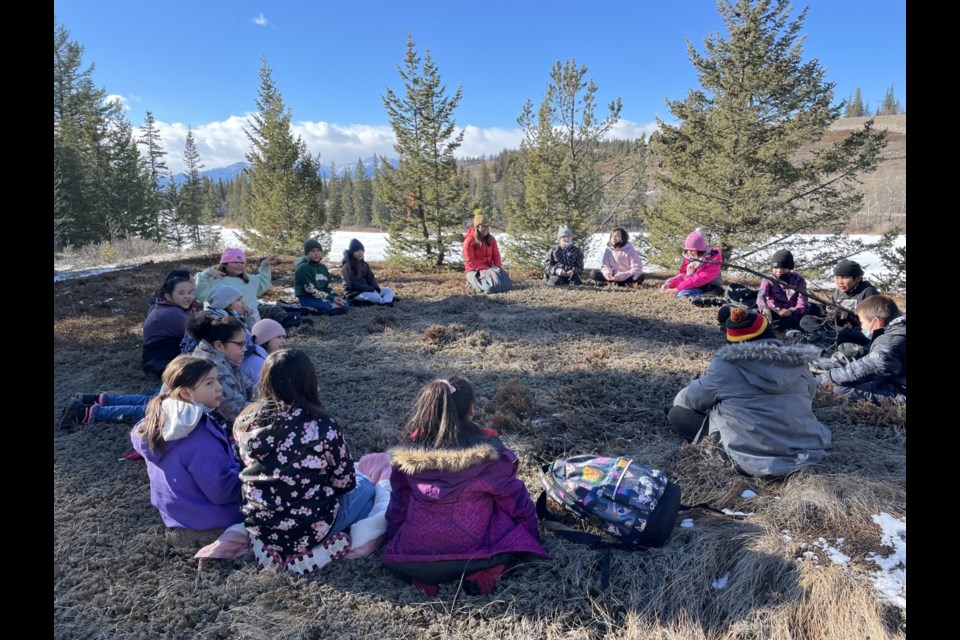STONEY NAKODA – Schools across Îyârhe Nakoda First Nation are tearing a page out of Nakoda Elementary School’s (NES) textbook to offer a ‘wild’ new program to all Stoney Education Authority (SEA) classrooms.
NES Wild, a land-based learning course started in the Mînî Thnî elementary school’s Grade 4 classrooms last year, is taking students from all grades outside to test their skills against the outdoors, learn from the land and recognize and embrace their connection with it.
“It’s much more than just outdoor learning; it’s [students] understanding who they are and where they come from,” said NES principal Aimee Cutknife. “It integrates language, culture, history, and anything that pertains to Indigenous or First Nations communities and ties into land-based learning.”
Emily Parkin and Amy Sagan, who taught Grade 4 at NES last year with educational assistants Sharon Benjamin and Megan Lefthand, are now taking classes outside every day from NES, Morley Community School, Chief Jacob Bearspaw School in Eden Valley and TaOtha Community School in Big Horn, to what they call their “forest classroom.”
Both teachers have several years combined experience in outdoor education and said the Grade 4 curriculum was a perfect fit for introducing the program, with support from school administration.
“There’s a plant unit and a whole social studies unit called Alberta: The Land, Histories and Stories,” said Sagan. “Everything we found in some of our textbooks we could actually bring outside on some level.”
Last year, students grew plants from seed outdoors and indoors to compare growth variables, studied biodiversity and ecosystems from animal bones found on the land, and learned about fire safety and cooking over the fire, among other things.
Some lessons require students to take calculated risks, like while building fires, which helps to strengthen confidence alongside skill.
“Through that, leadership skills start to emerge; and identity – they’re connecting to their culture, they’re hearing their language,” said Parkin. “There are so many things going on around them that contribute to the learning experience.”
Cutknife said the program distinguishes itself from other outdoor education classes because it indigenizes the curriculum wherever possible, something the school strives to do.
“We’re not really using the term outdoor education; this is different,” said Cutknife. “The one thing I always say is, the curriculum shouldn’t be made for our students to fit it; instead, it should be made to fit the students."
One way NES does this is by integrating Îyârhe Nakoda First Nation educational assistants, who are fluent in the Stoney language, in every classroom.
Last year’s Grade 4s had support from Benjamin and Lefthand, who helped to indigenize and localize NES Wild lesson plans specific to the Nation.
Community knowledge keepers and elders were also invited to have a say in teachings before the program started and afterward through weekly visits to the school and with the students.
“Before the program took off, we sat with the community members exactly where we’re sitting now,” said Cutknife, from a circle of Adirondack chairs in the program’s indoor classroom at NES. “We told them how we wanted this program to look and the feedback that we got from them was amazing.
“They told us they had been waiting for something like this for years. They were waiting to get involved and to have our children learn all these great things – not just with the curriculum, but within their own history.”
Some of the same elders and knowledge keepers were already visiting the school each week through a panel program started earlier in the year for all students from pre-Kindergarten through Grade 5.
Benjamin said NES is fortunate to work with community members who are knowledgeable of the Îyârhe Nakoda culture and language and stressed the importance of sharing their teachings with younger generations.
“We’ve lost a lot of people and a lot of information has gone with them … we can never retrieve it,” said Benjamin. “But now we have this opportunity to share these lessons.”
Over time, this organized knowledge-sharing will become a natural part of helping students shape their identities.
“They’ll just have this knowledge by the time they get to Grade 12,” said Benjamin. “They’ll have a better understanding of their traditional territory and how to use the land, and I think they will become stronger in who they are, and we’ll have a happier community.”
Plans to introduce NES Wild into other SEA schools began last year. Cutknife said it was clear all those involved in the program had built something unique based on the growth they witnessed in the Grade 4 classes.
The school board’s data coordinator also found Sagan and Parkin’s classes to have higher average attendance numbers than others.
“We as admin came to an agreement that this is where our school needs to be; this is what all classrooms need to be doing,” said Cutknife.
With support from SEA, NES Wild will be carried out in all four schools with some adjustments to fit different grade levels from pre-Kindergarten to Grade 12.
Given that the program is still in its early stages, Cutknife said she's eager to see what else comes of it as it grows.
“I’m super excited to see what flourishes and what else can come about from this program now that we have people designated to it to foster and expand it,” she said.




